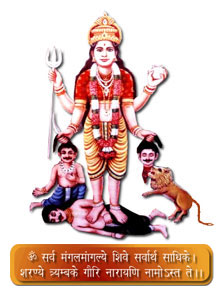Shri Mahalasa Story :
Churning of Ocean :
Once the Asuras (demons) were fighting with the Devas (demi-gods) and the Devas were losing. In desperation, they went to seek help. Brahma told them to go to the ocean of milk where Vishnu resides and to churn the ocean of milk until they obtain Amrit (divine nectar of immortality). They immediately went to the ocean and used the mountain, Mount Mandara as the churning rod and the king of serpents, Vasuki as the churning rod. Later the Devas realized that they could not churn the ocean on their own and they needed help. The Devas then decided to make peace with the Asuras and requested their help in the churning of the milk ocean. They tried to churn but the mountain sank into the ocean floor. Vishnu then took the form of a gigantic (huge) tortoise, Kurma and supported the mountain on his back. Using kurma as a base, they started to churn again. As the churning resumed, poison (hal hala) first emerged from the ocean. Lord Shiva took the poison and drank it. Parvati held his neck preventing him from swallowing the poison. This is why Shiva is called the blue-throated one. After that, great wealth like jewels, gold, the wish-fulfilling cow and Laxmi herself emerged from the ocean but this did not stop them from churning.
Shri Vishnu as Mohini :
Finally Amrit flowed out from the ocean and immediately the Asuras had desires to steal it. On seeing this, Vishnu took the form of a beautiful divine female called Mohini. The Asuras, not knowing that the Mohini is Vishnu himself but infatuated by her beautiful appearance prayed her to distribute amrit among them. Mohini condescended to do it but on condition that they would not question her actions, whatever they might be. The Asuras, not knowing who she was and totally under the spell of her charm, readily agreed to her condition. "Go bathe and assemble yourselves in one row with your cousins, the Devas in another row." ordered Mohini. When they were all assembled in two separate rows, Mohini began serving the Nectar to the Devas first. Mohini is one of the 25 anshs of Lord Vishnu as found in puranas. After getting Amruta both Devas and Danavas started quarrelling to drink that Amruta. At this point to avoid Danavas to drink Amruta and be immortal Lord Vishnu’s beautiful and charming Ansha took place as Mohini to destroy Danavas (Daits). Mohini started serving Amruta in bowl to only Devas. But in that line one Daitya managed to get in and drink the Amruta. The moment Mohini came to know that a daitya has drunk the portion of Amruta. Mohini (Lord Vishnu) sent his sudarshan chakra and severed his head from body, but the Amruta made him immortal. The head part of daitya is called Rahu and the lower body portion is called as Ketu. (This situation is seen in photo of Sri Mahalasa holding a head of Daitya. This Mohini form of Lord Vishnu prayed by Hindus as Godess.
"Shri Mahalasa Narayani Devi" :
Mahalasa is another name of the Mohini avatar. In Goa and elsewhere, Mahalasa is entirely considered as the Mohini form of Lord Vishnu and hence she is referred to as "Mahalasa Narayani". The deity, it may particularly be noted, also wears the holy thread, which is its unique feature. This holy thread is only worn by Brahmins and the male Gods. No other female God in the Hindu Pantheon wears this kind of thread except Goddess Mahalasa. The Goddess was originally located in Nepal during the Kaliyuga. She moved to Aurangabad in Maharashtra. During the Mughal domination, Aurangabad fell under the Muslim rule and the idol was moved to a secret location in Goa. Later, a small temple was built at Verna. Roughly, a few hundred years later, the Portuguese conquered Goa, and as a consequence the Goddess was moved to Mardol and later moved to mudgeri. Today the main temple is located in Mardol and alongwith the main Goddess, Shree Santeri and Laxminarayan are worshipped. The five main ganas of the Goddess namely Grampurush, Bhagwati, Dadh, Simha Purush and Mhal Purush are also located within the same temple premises and daily worship of all these deities is carried out before worshipping the main Goddess. Additionally, the popularity of the Goddess has increased so much in recent years that new temples have been established in Kumta, Kundapura, Udupi, Mangalore, mudgeri and other areas mostly along coastal Karnataka.










